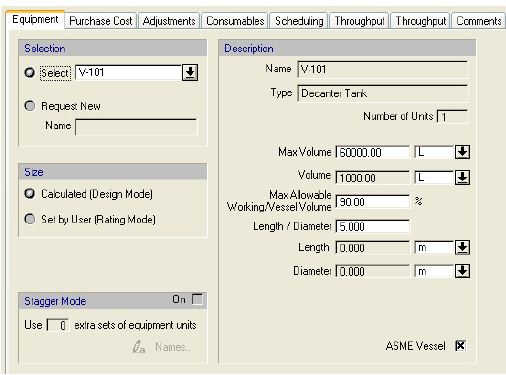

The following table shows the meaning of the variables appearing in this tab, as well as their default values and their generally acceptable range. Note that due to the manner by which the variables are used by the sizing and costing equations, the range of acceptable values may be further reduced.
|
Variable |
Default Value |
Range |
|
|
||
|
◙ Volume |
0.0 L |
Positive |
|
◙ Max Volume |
60,000 L |
Positive |
|
○ Max Allowable Working/Vessel Volume |
90% |
(0,100] |
|
○ Length/Diameter |
90% |
(0,100] |
|
● Length |
5.0 |
Positive |
|
● Diameter |
0 m |
Positive |
|
○ Is ASME Vessel? |
Yes |
Yes/No |
Symbol Key: ○ User-specified value (always input); ● Calculated value (always output); ◙ Sometimes input, sometimes output
In Calculate (Design Mode), the user specifies the max volume, and the program calculates the number of units and vessel volume based on the volume demand that is specified by the operation carried out as part of the unit procedure hosted by the equipment resource. If that volume exceeds the maximum volume specification then the software will assume multiple number of identical units whose unit volume does not exceed the max volume specification and whose total volume is equal to the volume demand. From the vessel volume and the length-diameter aspect ratio, the actual dimensions of each vessel (length and diameter) are calculated.
To calculate the demand on vessel volume by the operation, the demand on liquid volume by the operation is divided by the operation’s working to vessel volume ratio. The equipment’s min and max allowable working to vessel volume ratio limits act as constraints on the operation’s working to vessel volume ratio (i.e., the operation’s working to vessel volume ratio must be within the range defined by the equipment’s min and max working to vessel volume ratio limits).
For more information on sizing of the decanting tank, see Decanting: Modeling Calculations.
In User-Defined (Rating Mode), the volume of the vessel and the number of units are provided by the user. As in the design mode case, the actual dimensions of each vessel (length and diameter) are calculated from the vessel volume and the length-diameter aspect ratio. The program also calculates exactly as in the design mode case the demand on vessel volume by the operation carried out as part of the unit procedure(s) hosted by the equipment resource, and if the operation’s vessel volume demand of exceeds the actual vessel volume, it generates an error.
The equipment purchase cost is based on the total vessel volume, and is calculated by the built in model for a decanting tank with a minimum volume of 1000 L. Other factors that affect the cost are:
● Conforming to ASME Specification; if checked, then the vessel is assumed to have been constructed according to standards published by the American Society of Mechanical Engineers (ASME) and it is assumed to withstand pressure up to 35psig. Checking this option penalizes the cost by about 20% over the base cost.
For more information on this equipment, see Decanter Tank.
For information on the left-hand side variables and options, see Equipment Data Dialog: Equipment tab.